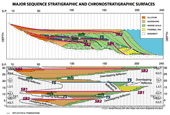|
chronosome
chronostratigraphic correlation chart
downlap
highstand systems tract (HST)
lowstand systems tract (LST)
maximum flooding surface
onlap
ravinement erosion surface
sequence boundary
shelf margin systems tract (SMST)
transgressive surface
transgressive systems tract (TST)
unconformity
Wheeler diagram


|
The establishment of the time significance of contemporaneous sedimentary units using biostratigraphy, radiometric methodologies and other time significant schemes.
Common bounding discontinuities used to subdivide the stratigraphic section can include:
• Unconformities or sequence boundaries (SB1 and SB2)
• Ravinement and/or trangressive surfaces TS),
• Maximum flooding surfaces (mfs)

Figure above is an example of a Chronostratigraphic chart or Wheeler diagram
Paraphrasing Zalasiewic et al (2013) matching the common usage terminiology by sequence stratigraphers propose that chronostratigraphy includes all methods (e.g., biostratigraphy, magnetostratigraphy, chemostratigraphy, cyclostratigraphy, sequence stratigraphy) so as to:
(1) establish the relative time relationships of stratigraphic successions regionally and worldwide
(2) formally name bodies of stratified rock that were deposited contemporaneously with units formally defined at their base, ideally by a GSSP (Global Boundary Stratotype Section and Point = “golden spike”) that represents a specific point in time.
Geochronologic units may be defined and applied generally by either GSSPs or—as currently in most of the Precambrian—by Global Standard Stratigraphic Ages (GSSAs).
They propose geochronology expresses the timing or age of events (depositional, diagenetic, biotic, climatic, tectonic, magmatic) in Earth’s history (e.g., Hirnantian glaciation, Famennian-Frasnian mass extinction). geochronology can also qualify rock bodies, stratified or unstratified, with respect to the time interval(s) in which they formed (e.g., Early Ordovician Ibex Group). In addition, geochronology refers to all methods of numerical dating.
Thus geochronologic units are proposed by Zalasiewic et al (2013) to be time units that include eons/eras/periods/epochs/ages, while chronostratigraphic units are the timerock units eonothems/erathems/systems/series/stages. Both hierarchies have geological context and Zalasiewic et al (2013) encourage a determination of the appropriate usage of
the component units by the International Commission on stratigraphy.
References
Mitchum Jr., R.M., 1977, Seismic stratigraphy and global changes of sea level. Part 11: glossary of terms used in seismic stratigraphy. In: Payton, C.E. (Ed.), Seismic stratigraphy––Applications to Hydrocarbon Exploration, vol. 26. A.A.P.G. Memoir, pp. 205–212.
Wheeler, H.E. 1958, Time stratigraphy. American Association of Petroleum Geologists, Bulletin, v. 42, p. 1047-1063
Wheeler, H.E. 1964, Baselevel, Lithosphere Surface, and Time-Stratigraphy, Geological Society of America Bulletin, July 1964, v. 75, no. 7, p. 599-610
Zalasiewicz, Jan., Maria Bianca Cita, Frits Hilgen, Brian R. Pratt, André Strasser,
Jacques Thierry, and Helmut Weissert, 2013, Chronostratigraphy and geochronology: A proposed
realignment, GSA Today, v. 23, no. 3, doi: 10.1130/GSATG160A.1.
|